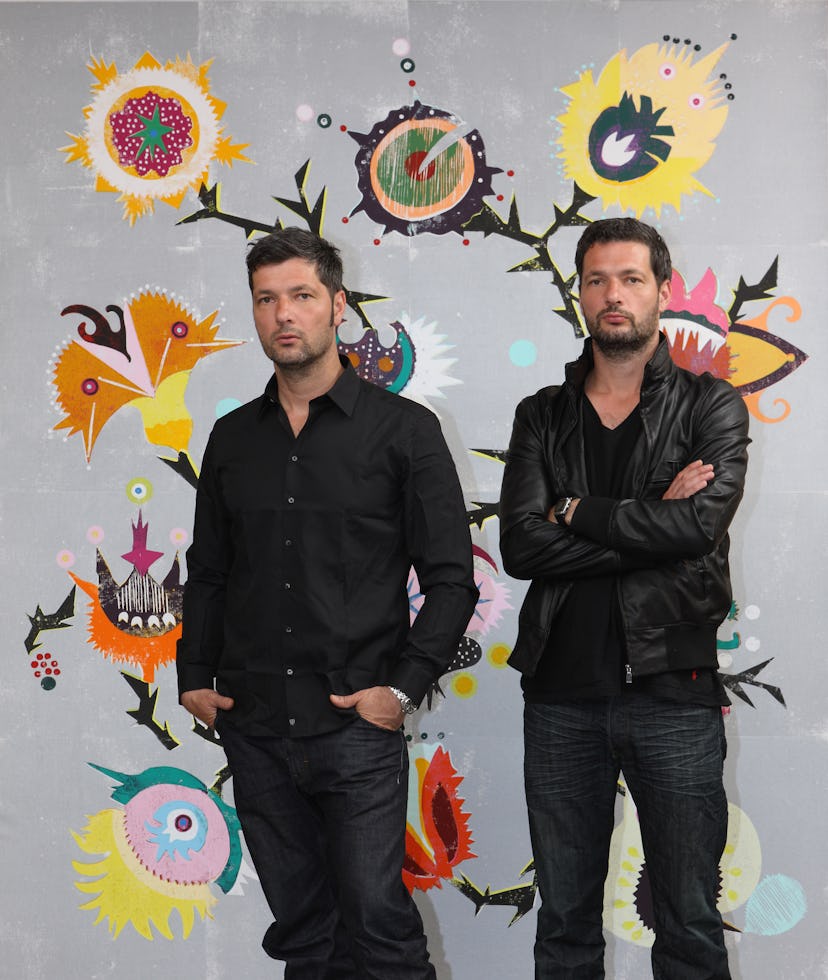Double or Nothing

Mike and Doug Starn
Ever since their 1986 breakout New York show, the New Jersey–bred twins Mike and Doug Starn have operated on the principle of “random interdependence”—another way of saying that everything’s connected. That idea, which they believe could easily stem from their genetic bond, drove the taped-together images of their early photographic tapestries as much as it did the immense Big Bambú. The climbable sculpture, first shown publicly in 2010 on the roof of New York’s Metropolitan Museum, grows and changes with each new iteration. At the Setouchi Triennale, in Japan, for example, they anchored the structure to a living bamboo forest, its elevated pathways rising to the treetops, where they floated a 60-foot-long bamboo boat. (For his epic, Noah, the film director Darren Aronofsky asked the Starns to create bamboo scaffolding for the ark.) The meaning of Big Bambú, says Mike Starn, lies in “what we see as the invisible architecture of life. Everything is made of smaller pieces and is part of something else.” Ironically, he notes, even though the brothers, 53, are each married with children, “Doug and I were always loners.”
Wilsons portrait by TAPE’, 2012. © Jane and Louise Wilson and 303 Gallery, New York.
Jane and Louise Wilson
Identical twins Jane and Louise Wilson, 47, work, think, and speak as one, in almost indistinguishable voices. The sisters share a studio in-London, and it’s difficult, even for them, to say who plays what role in realizing their large-scale photographs and videos. “It helps that there are two of us,” Jane says. “Yeah,” Louise nods. “One picks up the slack when the other’s feeling depleted.” The Wilsons attended art school in different cities, but for their graduation they made joint thesis projects—the scene of a suicide pact in which both appeared—that they exhibited concurrently. Since then, they have become known for documenting the aftermath of atrocities in their images of the former headquarters of the East German secret police, Nazi bunkers, and the toxic remains around Chernobyl. In October, their new commission for London’s Imperial War Museum will mark the centennial of World War I.
Os Gêmeos in front of a mural for Associação Comunitária Despertar, Brazil, 2013. Courtesy of artists.
Os Gêmeos
As teenagers, identical twins Gustavo and Otavio Pandolfo, known as Os Gêmeos, began painting together on buildings in their native São Paulo, developing monumental public murals in a richly patterned palette depicting elongated figures with large heads, bulging torsos, and skinny legs. “Later, we discovered that people called it art,” Gustavo says. “We said, ‘Cool!’ ” The brothers, who are now 40, started drawing at age 5, inspired by an older brother who is also an artist, ’80s hip-hop culture, and their love for *Ultra*man, a Japanese television program full of monsters. Ultimately, they decided against art school. “We didn’t want anything to distract us from our own world,” Gustavo explains. The brothers will show their latest paintings and kinetic sculptures with interactive touch-screens at Galeria Fortes Vilaça in São Paulo in June; another exhibition will follow in New York at Lehmann Maupin in 2015. They live in the same building, one floor apart, and work together so seamlessly that they do so in silence. “Gustavo knows everything I think,” Otavio says.
Tobias brothers portrait by Alistair Overbruck, 2013. Courtesy of Team Gallery, New York.
Tobias Brothers
Born in Transylvania, identical twins Gert and Uwe Tobias live in Cologne, Germany, in a building they co-own. Although best known for their enormous, expressive woodcuts—colorful tableaux of collaged household objects, typography, and Transylvanian folk figures-—they also produce drawings, collage books, ceramics, and, lately, carpets woven in Tibet. For source material, they look to art history as well as to folk and applied art, relying heavily on a vast trove of books they collect. Though the brothers, 41, attended the same German art school and studied with the artist Walter Dahn, their collaboration began upon their graduation, when it became apparent that what they made together was stronger than anything they made apart. “It started as a family thing,” Uwe says, explaining that they first created traditional woodcuts with their father, mother, and sister. Today, they use an electric saw to cut wood into puzzlelike blocks, working separately on pieces they’ve designed collaboratively and then choosing together which ones to exhibit. “We talk during that process,” Gert says. “But it’s important that we each have our own freedom.” Adds Uwe, “What matters is the result, not who does what.”
Photos: Double or Nothing
Starn brothers portrait by Wolfgang Wesener, 2010. Courtesy of WOWE.
Big Bambú #8, Benesse Art Site Naoshima, Setouchi Triennale, Teshima, Japan, 2013. Courtesy of Doug and Mike Starn.
Wilson sisters’ Biville, 2006. © Jane and Louise Wilson and 303 Gallery, New York.